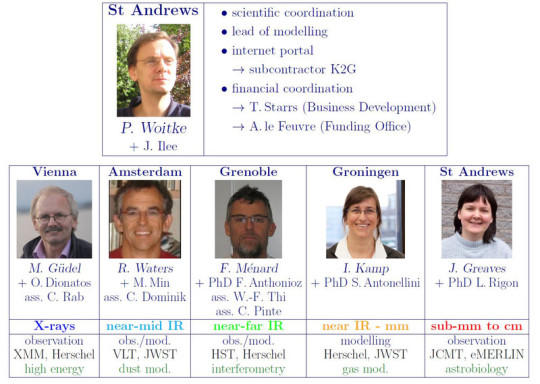The FP7-Project – DIANA
Figure 1: Sketch of the two-dimensional disc structure and the various disc components that we observe over the entire wavelength range (after Fig. 1 of Dullemond & Monnier 2010). The top arrows show which techniques can spatially resolve which scales
Space missions currently in operation (HST, SPITZER, HERSCHEL, XMM, in the future JWST) produce data of immense value for protoplanetary disc and planet formation research, but require additional funding to maximise the scientific return through comprehensive analysis and detailed modelling. Figure 1 visualises the potential of our approach. With the Spitzer legacy and now with Herschel the spectral gaps are closing, and the study of gas emission lines has become a new major target in disc research, with obviously large diagnostic potential. Every spectral line requires specific density, temperature, and irradiation conditions and, therefore, probes a particular spatial region in the disc (Fig. 1, r.h.s.). Only with detailed models, explaining both continuum and lines in different wavelength domains, can we break the degeneracy of SED-alone fitting. This is a challenging endeavour that is rarely attempted – many papers in the field study only one disc with detailed modelling.
In order to generalise these demanding studies to a high number of discs (around 40-50, necessary to explore the wide parameter space of exo-planet systems), we are supported by FP7-SPACE.

The compilation of multi-wavelength data sets requires international teamwork, and our team is selected to bring access to a wide range of existing data and future observational programmes, with one expert being assigned to each wavelength domain (X-ray, UV, optical, near-mid IR, far-IR, sub-mm, mm and beyond). We have the capacity to analyse and interpret data from large surveys in all wavelength regimes, and we will invest our expertise to request further observing time to address specific open issues. Every wavelength regime has its own specific physical, chemical and radiative processes to be included in the models. This modelling expertise is also well covered by our team. A collaboration like ours is rare and clearly novel, because the various communities (X-rays, optical/NIR, far-IR/mm) have interacted only poorly on such issues in the past. However, the wealth of new data and the complex nature of discs require exactly such collaborations.
Fig 3: Pert diagram to visualise work package inter-dependencies
The work in this FP7 project is subdivided into several work packages (WPs) as visualised in Fig 3. The data collection (WP1) is complemented by equally large efforts to model 40-50 individual sources (WP2), supplemented by three smaller work packages (WP3, WP4, WP5) which enhance the capabilities and applicability of our disc modelling software products MCMOST, MXMax and ProDiMo. A thorough analysis of the results, analysing the trends in data and models, will be performed in WP6. As far as these dependencies can be inverted, we will be able to identify new robust methods and easy-to-apply recipes for diagnostic purposes, for example to measure disc flaring and the degree of dust settling. The model trends will be carefully checked against the observational trends, and the overall quality of our models will be judged on the basis of the achieved degree of agreement between these trends.
To summarise, this is why we think that this FP7-SPACE project will make a difference:
- Collecting complete data samples across the electromagnetic spectrum – as far as feasible – for a well selected sample of disc-surrounded pre-main sequence stars to build an archive of standard data for further investigation. This includes high-quality spectra, photometry, and images from frontier instrumentation.
- Uniform reduction of all data to bring them to the same standard for each data type, permitting equal treatment and comparison of results.
- Coherent analysis and interpretation of the information content in all data sets, using identical analysis software for a given type of data set, and identical tools and data bases (e.g., for atomic or molecular physics) for spectral or image interpretation.
- Offering these easy-to-use reduced data sets and their analysis to the community.
- Use of high-quality, cutting-edge disc models including all relevant physical, chemical and radiative processes.
- Detailed treatment of dust opacities, dust energy balance and radiative transfer to obtain the radiation field at every point in the disc.
- Profound modelling of non-LTE line formation mechanisms (collisions, radiative and fluorescent excitation, chemical excitation) to understand which emission lines probe what physical processes in which part of the disc.
- Consistent formulation of the gas energy balance and the vertical extension, hence the shape of the disc.
- Computational know-how for statistical analyses, production of model grids, and data visualisation.
We are convinced that this is the most powerful way to exploit the European space mission data in the field of protoplanetary disc research. In particular, we want to derive the physical and chemical conditions in protoplanetary discs from these multi-wavelength data, key ingredients to understand the process of planet formation, disc evolution, and the outcoming architecture of exo-planetary systems.